从API版本升级到4.6之后, Unity支持了async和await语法, 并且根据测试来看, 它运行在主线程里, 跟一般的C#编译不大一样, 这就很有操作空间了, 先来看看普通C# Console工程和Unity中运行的差别:
1. C# Console
using System; namespace AsyncTest { class Program { static void Main(string[] args) { Console.WriteLine("Hello World!"); Console.WriteLine("Main : " + System.Threading.Thread.CurrentThread.ManagedThreadId); // 1 Test(); Console.ReadLine(); } async static void Test() { await System.Threading.Tasks.Task.Delay(TimeSpan.FromSeconds(5)); Console.WriteLine("Async : " + System.Threading.Thread.CurrentThread.ManagedThreadId); // 4 } } }
运行结果可以看到运行在不同的线程里面 :
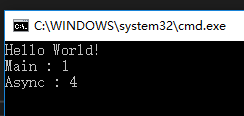
2. Unity
using UnityEngine; public class AsyncAwaitTest : MonoBehaviour { void Start() { Debug.Log("Main : " + System.Threading.Thread.CurrentThread.ManagedThreadId); // 1 Test(); } async static void Test() { await System.Threading.Tasks.Task.Delay(System.TimeSpan.FromSeconds(5)); Debug.Log("Async : " + System.Threading.Thread.CurrentThread.ManagedThreadId); // 1 } }
运行结果可以看到运行在主线程里面 :

这样的好处是什么呢? 第一个是它跟协程一样了, 通过不同的await方法返回不同的对象实现协程的作用, 我发现它可以使用 WaitForSeconds 这些Unity自带的控制类型, 比较神奇, 看下面测试:
using UnityEngine; public class AsyncAwaitTest : MonoBehaviour { void Start() { Debug.Log("Main : " + System.Threading.Thread.CurrentThread.ManagedThreadId); Debug.Log("Time1 : " + Time.time); Debug.Log("Time2 : " + System.DateTime.Now.ToString("HH:mm:ss fff")); Test(); } async static void Test() { //await System.Threading.Tasks.Task.Delay(System.TimeSpan.FromSeconds(5)); Time.timeScale = 2.0f; await new WaitForSeconds(2.0f); Debug.Log("Async : " + System.Threading.Thread.CurrentThread.ManagedThreadId); Debug.Log("Time3 : " + Time.time); Debug.Log("Time4 : " + System.DateTime.Now.ToString("HH:mm:ss fff")); } }
运行结果如下:
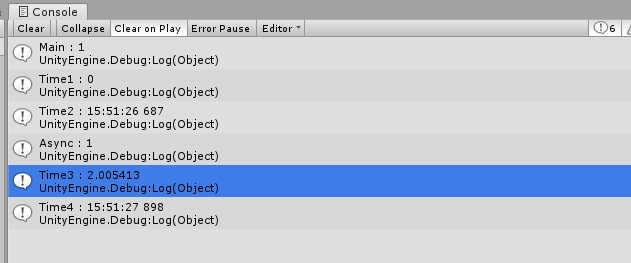
上面的运行在开始时调整了Time.timeScale, 然后等待的时间 WaitForSeconds(2.0) 运行结果也是正确的, 看到游戏时间过了2秒, 实际时间过了1秒, 也就是说Unity中对await的返回进行了整合, 自带的YieldInstruction也能被await正确返回. 这样async方法就能直接当做协程来用了.
测试一下多个async嵌套运行的情况:
using UnityEngine; public class AsyncAwaitTest : MonoBehaviour { void Start() { Debug.Log("Main : " + System.Threading.Thread.CurrentThread.ManagedThreadId); Debug.Log("Time1 : " + Time.time); Debug.Log("Time2 : " + System.DateTime.Now.ToString("HH:mm:ss fff")); Test(); } async void Test() { Time.timeScale = 2.0f; await new WaitForSeconds(2.0f); Debug.Log("Async : " + System.Threading.Thread.CurrentThread.ManagedThreadId); Debug.Log("Time3 : " + Time.time); Debug.Log("Time4 : " + System.DateTime.Now.ToString("HH:mm:ss fff")); await Test2(); } async System.Threading.Tasks.Task Test2() { await new WaitForSecondsRealtime(2.0f); // Time.timeScale = 2.0f; Debug.Log("Async : " + System.Threading.Thread.CurrentThread.ManagedThreadId); Debug.Log("Time5 : " + Time.time); Debug.Log("Time6 : " + System.DateTime.Now.ToString("HH:mm:ss fff")); } }
运行结果 :
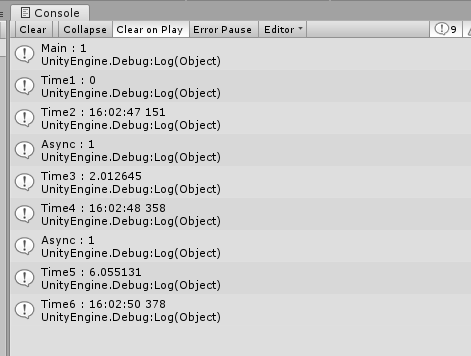
正确的结果, 因为在Test2中timeScale还是2, 使用realtime的话就是4秒的游戏时间.
都是在主线程中运行的, 这样看来因为async是语言级别的支持, 可能以后就没有协程什么事了, 使用async在写法上也比协程简单了一点, 我们试试用协程来写:
void Start() { Debug.Log("Main : " + System.Threading.Thread.CurrentThread.ManagedThreadId); Debug.Log("Time1 : " + Time.time); Debug.Log("Time2 : " + System.DateTime.Now.ToString("HH:mm:ss fff")); StartCoroutine(Test()); } IEnumerator Test() { Time.timeScale = 2.0f; yield return new WaitForSeconds(2.0f); Debug.Log("Async : " + System.Threading.Thread.CurrentThread.ManagedThreadId); Debug.Log("Time3 : " + Time.time); Debug.Log("Time4 : " + System.DateTime.Now.ToString("HH:mm:ss fff")); yield return Test2(); } IEnumerator Test2() { yield return new WaitForSecondsRealtime(2.0f); // Time.timeScale = 2.0f; Debug.Log("Async : " + System.Threading.Thread.CurrentThread.ManagedThreadId); Debug.Log("Time5 : " + Time.time); Debug.Log("Time6 : " + System.DateTime.Now.ToString("HH:mm:ss fff")); }
差别在StartCoroutine上, 反正我是经常忘了写它, 然后运行不起来的. 因为没有什么好方法测试两种方案的性能差别, 暂时先抛开性能吧.
然后是 WaitForEndOfFrame 在async是否正确的测试 :
using UnityEngine; public class AsyncAwaitTest : MonoBehaviour { bool update = false; void Start() { Debug.Log("Main : " + System.Threading.Thread.CurrentThread.ManagedThreadId); Debug.Log("Time1 : " + Time.time); Debug.Log("Time2 : " + System.DateTime.Now.ToString("HH:mm:ss fff")); Test(); } async void Test() { int i = 0; update = true; while(i < 10) { i++; Debug.Log("Async -- " + Time.frameCount); await new WaitForEndOfFrame(); } update = false; } void Update() { if(update) { Debug.Log("Update -- " + Time.frameCount); } } }
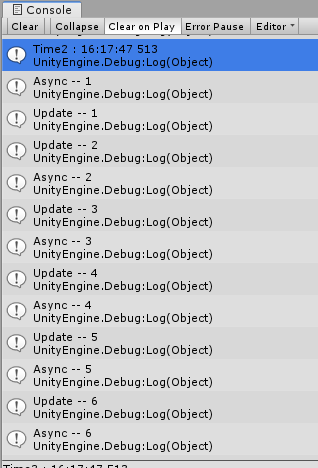
可以看到跟Update函数是交互进行的, 确实async能以YieldInstruction作为等待逻辑 (更正, 能以Unity已经创建好的YieldInstruction作为等待逻辑). 这些都验证了async-await 能够替代协程, 再来测试一个await对异步操作自动返回的类型的:
void Start() { Debug.Log("Main : " + System.Threading.Thread.CurrentThread.ManagedThreadId); Debug.Log("Time1 : " + Time.time); Debug.Log("Time2 : " + System.DateTime.Now.ToString("HH:mm:ss fff")); var loadPath = Application.streamingAssetsPath + "/mycube"; Load<GameObject>(loadPath, "MyCube", (_prefab) => { var go = GameObject.Instantiate(_prefab); go.name = "MyCube Loaded"; Debug.Log("Time3 : " + System.DateTime.Now.ToString("HH:mm:ss fff")); }); } async void Load<T>(string loadPath, string assetName, System.Action<T> loaded) where T : UnityEngine.Object { AssetBundle assetBundle = await AssetBundle.LoadFromFileAsync(loadPath); UnityEngine.Object asset = await assetBundle.LoadAssetAsync<T>(assetName); loaded.Invoke(asset as T); assetBundle.Unload(false); }
上面的代码用来读取一个AssetBundle中的GameObject, 在读取步骤 await AssetBundle.LoadFromFileAsync(loadPath); 返回的直接就是assetBundle了, 并且在 await assetBundle.LoadAssetAsync<T>(assetName); 直接返回的就是asset(Object)了, 这个可能也是Unity在编译层面做的改动吧, 所以经过测试正常API都能通过await返回.
这只是基本操作, 其实有更厉害的地方, 它能改变上下文达到跳转线程的作用. Unity有它自己的同步上下文叫做UnitySynchronizationContext, .NET中叫SynchronizationContext, 因为Unity使用的是.NET标准库, 所以继承了Task的ConfigureAwait功能, 它是告诉这个Task可以运行在其它线程上, 而如果上下文的线程进行了转换, 如果没有需要它就不会自动转回主线程. 测试一下 :
public class EnterWorkThread { public ConfiguredTaskAwaitable.ConfiguredTaskAwaiter GetAwaiter() { return Task.Run(() => { }).ConfigureAwait(false).GetAwaiter(); } } void Start() { Debug.Log("Main : " + System.Threading.Thread.CurrentThread.ManagedThreadId); Debug.Log("Time1 : " + Time.time); Debug.Log("Time2 : " + System.DateTime.Now.ToString("HH:mm:ss fff")); Test(); } async void Test() { Debug.Log("Async1 : " + System.Threading.Thread.CurrentThread.ManagedThreadId); await new EnterWorkThread(); Debug.Log("Async2 : " + System.Threading.Thread.CurrentThread.ManagedThreadId); GameObject.CreatePrimitive(PrimitiveType.Cube); }
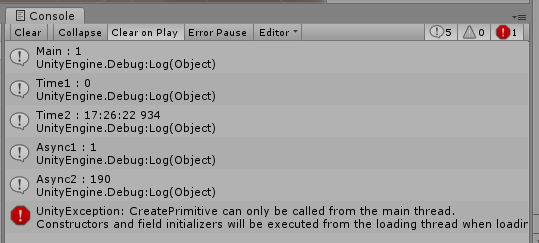
可以看到 await new EnterWorkThread(); 之后当前线程转换为了工作线程, 通过这个方式就把上下文转换到了其它线程里面. 后面运行的代码也继续在新线程中运行.
await 只需要返回对象有GetAwaiter方法即可.
那么要回到主线程有什么方法呢? 等待主线程的生命周期即可:
async void Test() { Debug.Log("Async1 : " + System.Threading.Thread.CurrentThread.ManagedThreadId); await new EnterWorkThread(); Debug.Log("Async2 : " + System.Threading.Thread.CurrentThread.ManagedThreadId); await new WaitForEndOfFrame(); Debug.Log("Async3 : " + System.Threading.Thread.CurrentThread.ManagedThreadId); Debug.Log(GameObject.CreatePrimitive(PrimitiveType.Cube).name); }
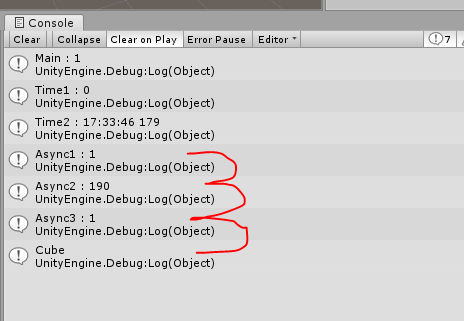
看到线程又回到了主线程, 并且调用API没有问题. 以后写多线程的代码可以很简单了!!!
(2020.03.06)
PS : 目前自己创建的对象只有继承于CustomYieldInstruction类的才能作为awaitable对象, 其它还是需要按照正常的C#方式来, 并且在执行这个之后一定会回到主线程, 这应该是Unity底层做了强制转换, 所以才有了这个写法的理论支持. 然后这个线程转换, 在回到主线程的时候都是要等待下一帧的, 跟我们自己写的逻辑差不多 :
void OnGUI()
{
if(GUI.Button(new Rect(100, 100, 100, 50), "Test"))
{
FrameTest();
}
}
async void FrameTest()
{
Debug.Log("Main : " + System.Threading.Thread.CurrentThread.ManagedThreadId);
Debug.Log("Frame : " + Time.frameCount);
await new EnterWorkThread(); // 工作线程
Debug.Log("WorlThread : " + System.Threading.Thread.CurrentThread.ManagedThreadId);
await new EnterMainThread();
Debug.Log("Main : " + System.Threading.Thread.CurrentThread.ManagedThreadId);
Debug.Log("Frame : " + Time.frameCount);
return;
}
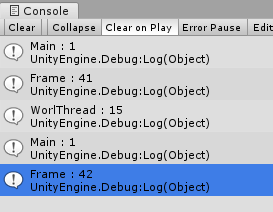
PS2 : 在工作线程中进行等待操作, 也需要另外封装才行, 如果使用Unity的会被强制回到主线程的, 可是即使自己封装, 也会被强制转换线程 :
public class WaitTimeWorkThread { private float _time = 0.0f; public WaitTimeWorkThread(float time) { _time = time; } public ConfiguredTaskAwaitable.ConfiguredTaskAwaiter GetAwaiter() { return Task.Delay(TimeSpan.FromSeconds(_time)).ConfigureAwait(false).GetAwaiter(); } } async void FrameTest() {
Debug.Log("Main : " + System.Threading.Thread.CurrentThread.ManagedThreadId);
await new EnterWorkThread(); // 工作线程1
Debug.Log("EnterWorkThread : " + System.Threading.Thread.CurrentThread.ManagedThreadId);
await new WaitTimeWorkThread(1.0f); // 工作线程2
Debug.Log("WaitTimeWorkThread : " + System.Threading.Thread.CurrentThread.ManagedThreadId);
}
结果很不理想, 在线程中还是被转换了线程 :
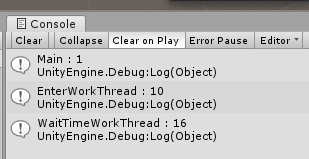
如果是多重嵌套的逻辑, 随着上下文转换的开销增加, 很难说性能影响的大小, 并且所有调用都要注意线程问题, 有些逻辑自带线程转换的, 就比较麻烦了, 虽然跟普通多线程比较方便了很多, 可是跟Job系统比起来又弱爆了, 各有各的好吧.
补充一下额外的相关信息, 一个普通协程它是可以被停止的, 通过关闭运行这个协程的GameObject, 或者是调用StopCoroutine方法, 我们使用async方法的话, 就很sucks了, 因为语言本身就没有提供停止Task的方法, 测试了它提供的CancellationToken简直就是个智障设计, 完全没有实际意义. 看看微软自己提供的例子 :
static async Task Main()
{
var tokenSource2 = new CancellationTokenSource();
CancellationToken ct = tokenSource2.Token;
var task = Task.Run(() =>
{
ct.ThrowIfCancellationRequested();
bool moreToDo = true;
while (moreToDo)
{
if (ct.IsCancellationRequested)
{
ct.ThrowIfCancellationRequested();
}
}
}, tokenSource2.Token); // Pass same token to Task.Run.
tokenSource2.Cancel();
try
{
await task;
}
catch (OperationCanceledException e)
{
Console.WriteLine($"{nameof(OperationCanceledException)} thrown with message: {e.Message}");
}
finally
{
tokenSource2.Dispose();
}
Console.ReadKey();
}
除了一句MDZZ之外还能说什么呢, 在所有代码前添加异常抛出吗? 在所有循环中自己添加吗? 简直弱爆了啊.
如果使用杀线程的方式不知道是否可行, 因为在这里的async模式下, 我们是可以不断转换线程的, 主线程的话怎么办? 不能杀线程也不能停止. 还有它进入工作线程的时候怎样记录线程ID也是个问题......
不管怎样, 它提供了另外一种协程或多线程的方式, 加上ECS on Job, 项目中就可以有满足各种需求的多线程框架了.